Topic 5: Misc. Questions
You plan to migrate on-premises Microsoft SQL Server databases to Azure.
You need to recommend a deployment and resiliency solution that meets the following requirements:
Supports user-initiated backups
Supports multiple automatically replicated instances across Azure regions
Minimizes administrative effort to implement and maintain business continuity
What should you recommendation? To answer, select the appropriate options in the answer area.
NOTE: Each correct selection is worth one point.
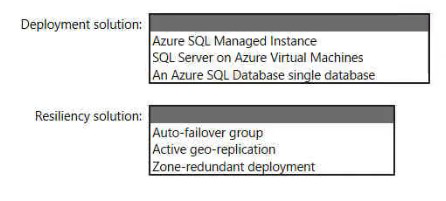
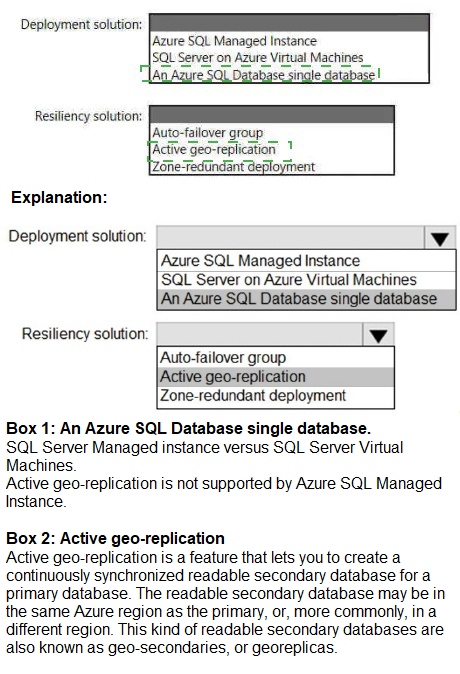
You have an Azure subscription.
You need to deploy an Azure Kubernetes Service (AKS) solution that will use Linux nodes.
The solution must meet the following requirements:
Minimize the time it takes to provision compute resources during scale-out operations.
Support autoscaling of Linux containers.
Minimize administrative effort.
Which scaling option should you recommend?
A.
Virtual Kubelet
B.
cluster autoscaler
C.
horizontal pod autoscaler
D.
AKS virtual nodes
AKS virtual nodes
You plan to create an Azure Storage account that will host file shares. The shares will be accessed from on-premises applications that are transaction-intensive.
You need to recommend a solution to minimize latency when accessing the file shares.
The solution must provide the highest-level of resiliency for the selected storage tier.
What should you include in the recommendation? To answer, select the appropriate options in the answer area.
NOTE: Each correct selection is worth one point.
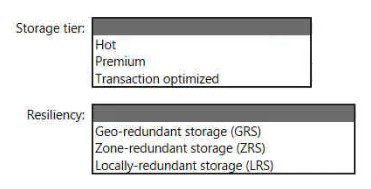
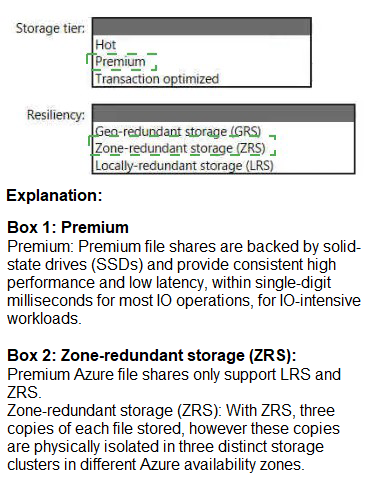
You have a .NET web service named Service! that performs the following tasks:
• Reads and writes temporary files to the local file system.
• Writes to the Application event log.
You need to recommend a solution to host Service1 in Azure. The solution must meet the following requirements:
• Minimize maintenance overhead.
• Minimize costs.
What should you include in the recommendation?
A.
an Azure Functions app
B.
an App Service Environment (ASE)
C.
an Azure virtual machine scale set
D.
an Azure App Service web app
an Azure virtual machine scale set
You need to design an Azure policy that will implement the following functionality:
• For new resources, assign tags and values that match the tags and values of the resource group to which the resources are deployed.
• For existing resources, identify whether the tags and values match the tags and values of the resource group that contains the resources.
• For any non-compliant resources, trigger auto-generated remediation tasks to create missing tags and values.
The solution must use the principle of least privilege.
What should you include in the design? To answer, select the appropriate options in the answer area.
NOTE: Each correct selection is worth one point.

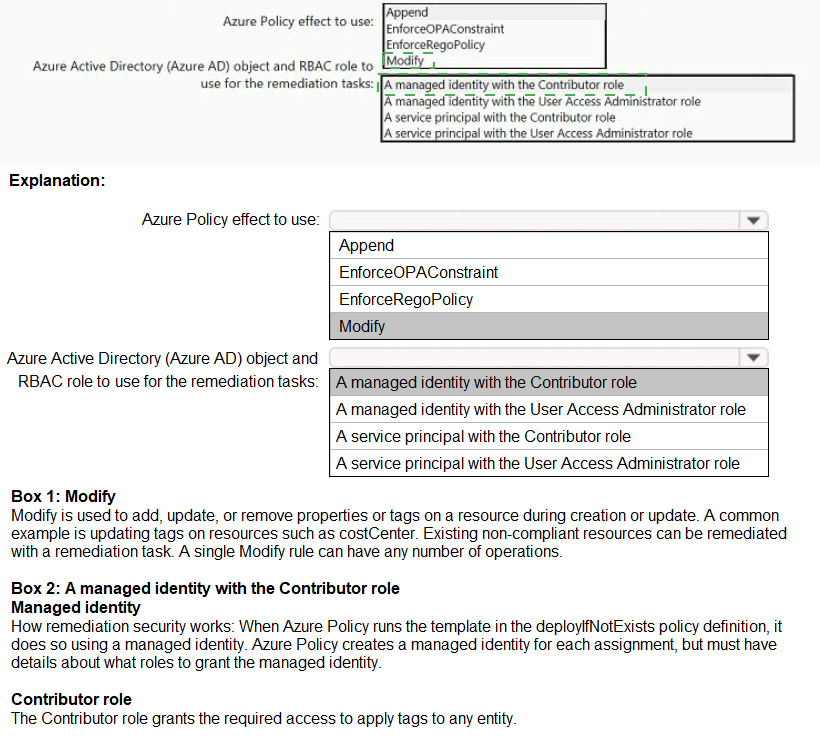
You have an on-premises app named App1.
Customers use App1 to manage digital images.
You plan to migrate App1 to Azure.
You need to recommend a data storage solution for Appl. The solution must meet the following image storage requirements:
• Encrypt images at rest.
• Allow files up to 50 MB.
• Manage access to the images by using Azure Web Application Firewall (WAF) on Azure Front Door.
The solution must meet the following customer account requirements:
• Support automatic scale out of the storage.
• Maintain the availability of App1 if a datacenter fails.
• Support reading and writing data from multiple Azure regions.
Which service should you include in the recommendation for each type of data? To answer, drag the appropriate services to the correct type of data. Each service may be used once, more than once, or not at all. You may need to drag the split bar between panes or scroll to view content.
NOTE: Each correct selection is worth one point.


You plan to develop a new app that will store business critical data. The app must meet the following requirements:
Prevent new data from being modified for one year.
Minimize read latency.
Maximize data resiliency.
You need to recommend a storage solution for the app.
What should you recommend? To answer, select the appropriate options in the answer area.

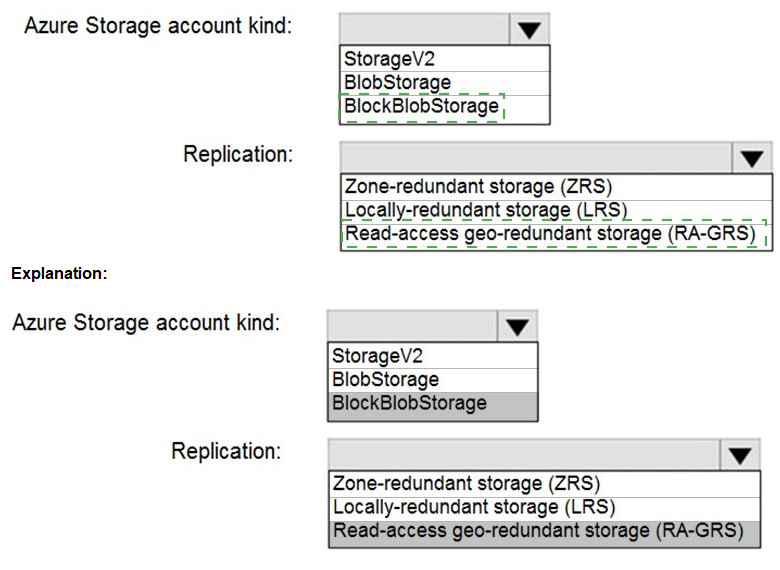
You have an on-premises file server that stores 2 TB of data files.
You plan to move the data files to Azure Blob storage in the Central Europe region.
You need to recommend a storage account type to store the data files and a replication solution for the storage account. The solution must meet the following requirements:
Be available if a single Azure datacenter fails.
Support storage tiers.
Minimize cost.
What should you recommend? To answer, select the appropriate options in the answer area.
NOTE: Each correct selection is worth one point.

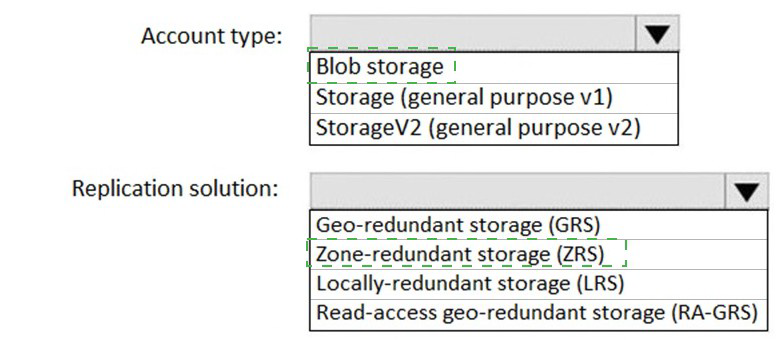
You have an on-premises Microsoft SQL Server database named SQL1.
You plan to migrate SQL 1 to Azure.
You need to recommend a hosting solution for SQL1. The solution must meet the following requirements:
• Support the deployment of multiple secondary, read-only replicas.
• Support automatic replication between primary and secondary replicas.
• Support failover between primary and secondary replicas within a 15-minute recovery time objective (RTO).

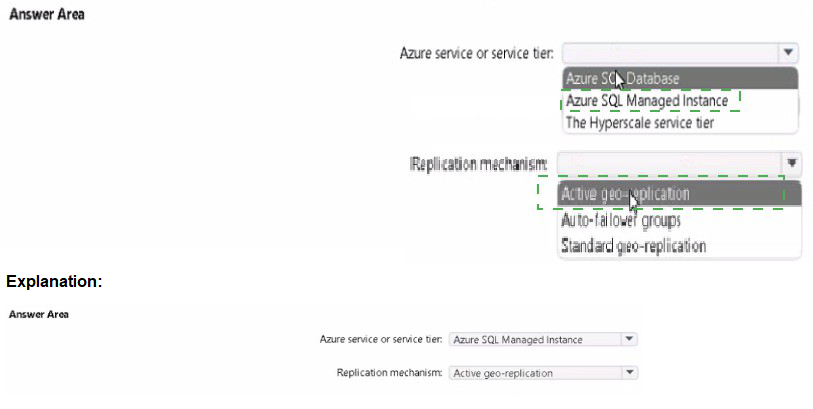
You have the Free edition of a hybrid Azure Active Directory (Azure AD) tenant. The tenant uses password hash synchronization.
You need to recommend a solution to meet the following requirements:
Prevent Active Directory domain user accounts from being locked out as the result of brute force attacks targeting Azure AD user accounts.
Block legacy authentication attempts to Azure AD integrated apps.
Minimize costs.
What should you recommend for each requirement? To answer, select the appropriate options in the answer area.
NOTE: Each correct selection is worth one point.
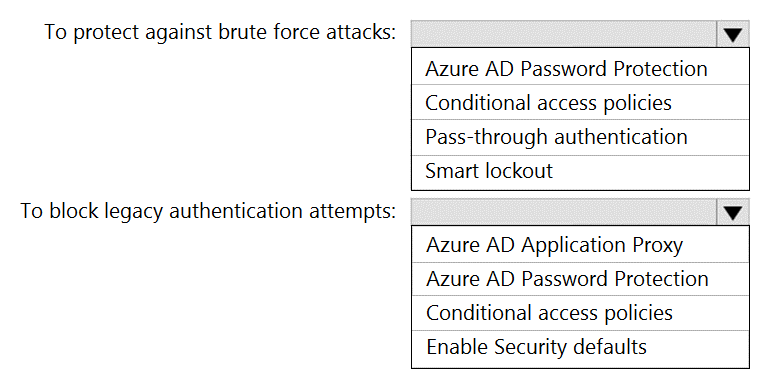
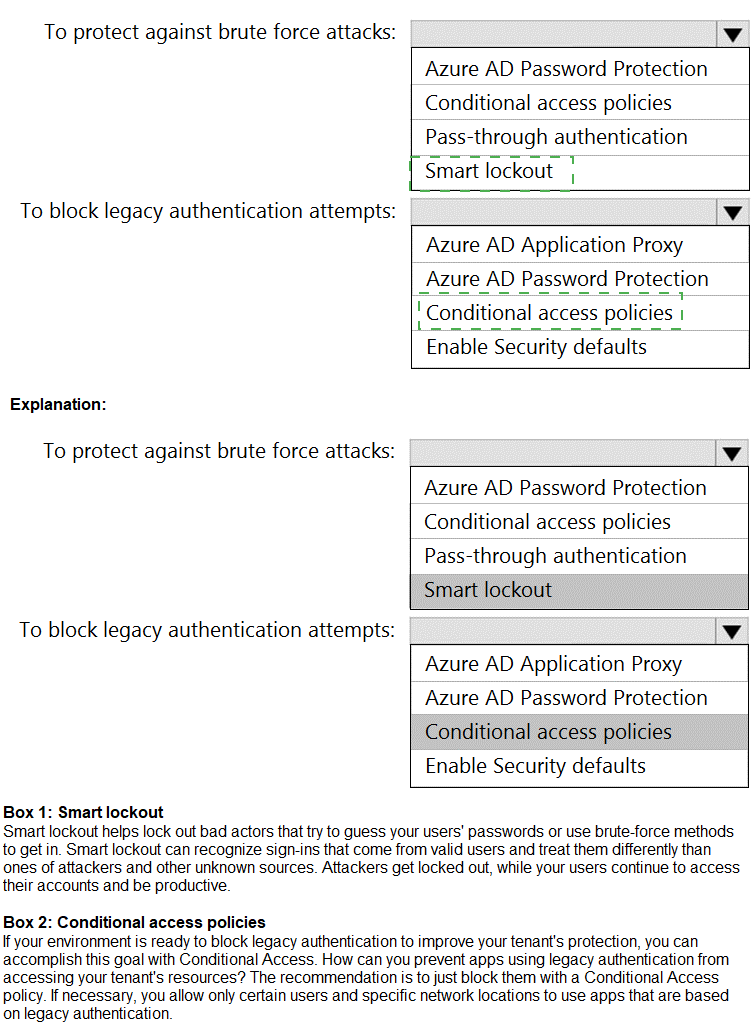
Note: This question is part of a series of questions that present the same scenario. Each question in the series contains a unique solution that might meet the stated goals. Some question sets might have more than one correct solution, while others might not have a correct solution.
After you answer a question in this section, you will NOT be able to return to it. As a result, these questions will not appear in the review screen.
Your company plans to deploy various Azure App Service instances that will use Azure SQL databases. The App Service instances will be deployed at the same time as the Azure SQL databases.
The company has a regulatory requirement to deploy the App Service instances only to specific Azure regions. The resources for the App Service instances must reside in the same region.
You need to recommend a solution to meet the regulatory requirement.
Solution: You recommend creating resource groups based on locations and implementing resource locks on the resource groups.
Does this meet the goal?
A.
Yes
B.
No
No
Explanation:
Resource locks are not used for compliance purposes. Resource locks prevent changes from being made to resources.
Reference:
https://docs.microsoft.com/en-us/azure/azure-resource-manager/management/lockresources
You need to design a highly available Azure SQL database that meets the following requirements:
* Failover between replicas of the database must occur without any data loss.
* The database must remain available in the event of a zone outage.
* Costs must be minimized.
Which deployment option should you use?
A.
Azure SQL Database Business Critical
B.
Azure SQL Database Managed Instance Business Critical
C.
Azure SQL Database Serverless
D.
Azure SQL Database Premium
Azure SQL Database Premium
Explanation: General Purpose / Standard prevents data loss through high available storage https://docs.microsoft.com/en-us/azure/azure-sql/database/service-tier-generalpurpose?view=azuresql. This architectural model relies on high availability and reliability of Azure Blob storage that transparently replicates database files and guarantees no data loss if underlying infrastructure failure happens. General Purpose / Standard support Zone Redundancy For General Purpose tier the zone-redundant configuration is Generally Available in the following regions: https://docs.microsoft.com/en-us/azure/azuresql/database/high-availability-sla?view=azuresql&tabs=azure-powershell Without any information regarding the usage pattern, serverless is possible. Other option is D.
https://docs.microsoft.com/en-us/azure/azure-sql/database/serverless-tieroverview?view=azuresql
| Page 4 out of 24 Pages |
| Previous |